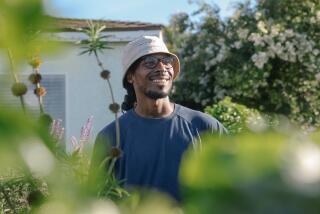Seed Seller Burpee Branches Into Plants
- Share via
WARMINSTER, Pa. — Connie Natal once had a huge vegetable garden with broccoli, lettuce, zucchini, Brussels sprouts, even a tomato that weighed almost three pounds.
The demands of motherhood--she has twin 15-year-old boys--put a stop to that. Now her gardening is limited to flowers, and she buys live plants instead of seeds.
“If you start from seed, you have to start them inside and really nurse them along,” Natal, 47, said recently as she left a suburban Philadelphia garden center. “I don’t have time for that.”
The W. Atlee Burpee & Co. is taking note of gardeners like Natal. Long regarded as the 800-pound gorilla of American seed companies, Burpee has diversified into live plants and even retail stores. And it has revamped its 5-year-old Internet site in a further effort to aid time-starved customers.
Tom Cooper, editor of Horticulture magazine, likes the strategy.
“Burpee may be old line, but I don’t think there’s anything sleepy about them,” he said.
Nationwide, the number of households buying live plants has increased dramatically over the last five years, while the number buying seeds has remained about the same, according to the National Gardening Association.
Lack of time, patience and experience are the most commonly cited reasons, as well as the booming economy that has people willing to spend extra for instant blooms.
Seed companies have been dealing with the problem since the 1980s, when home vegetable gardens began shrinking in size, said former Burpee employee Steve Frowine, now horticulture director at a Connecticut-based nursery.
At the same time, garden centers and the garden departments of larger chain stores began offering a better selection of bedding plants.
“The variety and quantity of small plants is way up over the last couple of years. It just shot up, and the customers are there,” said Mark Kane, executive garden editor of Better Homes & Gardens magazine.
Burpee, which will celebrate its 125th anniversary next year, concedes that more and more people are choosing plants over seeds. It is trying to adjust to that reality.
In recent years, the suburban Philadelphia company began selling 187 new and unusual varieties of annuals and vegetables as plants--species you won’t find at the typical garden center.
“It’s what people want, but they didn’t have time to grow them” from seed, said Dave Devine, director of product development.
In April and May, Burpee opened the first retail stores in its 124-year history, and Burpee plants have been flying out of them.
The first Burpee Gardens superstore opened in the Chicago suburb of Downers Grove in April. Two other stores followed in Medford, N.J., and Horsham, Pa.
The stores allow Burpee to get immediate customer feedback in a way that the company’s bread-and-butter--the venerable Burpee catalog--cannot. They also give Burpee another way to leverage its name brand.
Although the stores are doing big business--people have traveled as long as an hour-and-a-half to get to the one in Horsham--company executives worry about angering the 15,000 retail outlets that sell the Burpee seed line. So they’ve promised to open additional stores only to get a good geographic dispersion.
“If these stores are gushers, are we going to open up a new chain? That’s not our objective at all,” said George Ball Jr., Burpee’s president and chief executive officer and a third-generation seedsman.
Meanwhile, Burpee has entered discussions about selling its plants at other retail stores. The Burpee Gardens stores are a trial run for that.
“We don’t see a time when the seed business will go away, nor do we see a time when the catalog business goes away,” said Bill Clark, an assistant to Ball. “We do see that plants are becoming a much larger part of Burpee’s future.”
Change is nothing new for Burpee. The company has a long history of innovation dating back to 1876, when W. Atlee Burpee started the business with $1,000 in “seed money” from his mother.
Burpee, who was familiar with the still-novel theories of geneticist Gregor Mendel, developed his own experimental breeding program and produced many of the varieties that today’s gardener takes for granted: iceberg lettuce, the Big Boy tomato, the Fordhook lima bean, the first yellow sweet corn and others.
Later, the company introduced or popularized marigolds, zinnias, nasturtiums, hybrid impatiens and other staples of the flower garden.
Many of these varieties were developed at Fordhook Farm, the suburban Philadelphia plot where W. Atlee Burpee conducted his seed trials, beginning in the 1880s. Located on more than 60 bucolic acres, Fordhook once boasted the largest trial grounds in America.
Ball, a member of the Chicago-based Ball Seed family that bought Burpee in 1991, acquired Fordhook from W. Atlee Burpee’s descendants in 1999. It is now undergoing extensive renovation and eventually will become what company officials call a “horticultural mecca” for the gardening crowd.
Seed trials resumed on a limited basis last summer. This year, the number of plant species being tested at Fordhook is nearly tripling to 5,000, with 100,000 plants taking up 15 acres. Trials manager Sharon Kaszan calls the plants grown at Fordhook a “living Burpee catalog.”






